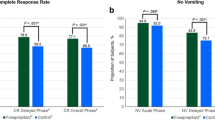Abstract
The antiemetic efficacy and safety of granisetron (40 μg/kg), a selective and potent 5-hydroxytryptamine (serotonin) antagonist, was compared with that of metoclopramide (7 mg/kg) plus dexamethasone (12 mg) in patients receiving fractionated chemotherapy. Patients receiving cisplatin at doses of at least 15 mg/m2 or etoposide at least 120 mg/m2 or ifosfamide at least 1.2 g/m2 on each of 5 consecutive days were eligible. A total of 143 patients received granisetron and 141 received the comparator regimen. The 5-day complete response rate (no vomiting, no worse than mild nausea) for granisetron (46.8%) was equivalent to that for metoclopramide plus dexamethasone (43.9%). The overall 5-day response profile was superior for granisetron (P=0.013) because of fewer failures in this group. The overall incidence of adverse experiences was significantly lower in the granisetron group (60.8% versus 77.3%,P=0.003). Headache and constipation, more prevalent in the granisetron group, are recognized side-effects of serotonin antagonists. Extrapyramidal syndrome, not seen in any granisetron patients, occurred in 20.6% of comparator patients (P<0.0001). The majority of granisetron patients only required a single prophylactic dose of the drug on each treatment day (at least 82%). In conclusion, granisetron showed at least equivalent efficacy to metoclopramide plus dexamethasone in patients receiving 5-day fractionated chemotherapy. In addition it offered a simple and convenient dosing regimen and a safer side-effect profile.
Similar content being viewed by others
References
Andrews PLR, Rapeport WG, Sanger CJ (1988) Neuropharmacology of emesis induced by anti-cancer therapy. Trends Pharmacol Sci 9:334–341
Blower PR (1990) The role of specific 5-HT3 receptor antagonism in the control of cytostatic drug-induced emesis. Eur J Cancer 26 [suppl 1]:S8-S11
Bunn PA, Minna JA (1985) Paraneoplastic syndromes. In: De Vita VT, Hellman S, Rosenberg SA (eds) Cancer: principles and practice of oncology. Lippincott, Philadelphia, pp 1797–1842
Chevallier B (1990) Efficacy and safety of granisetron compared with high dose metoclopramide plus dexamethasone in patients receiving high dose cisplatin in a single-blind study. Eur J Cancer 26 [Suppl 1]:S33-S36
Coates A, Abraham S, Kaye SB et al. (1983) On the receiving end-patient perception of the side effects of cancer chemotherapy. Eur J Cancer Clin Oncol 19:203–208
Gralla RJ, Itri LM, Pisko SE et al. (1981) Antiemetic efficacy of high dose metoclopramide: randomized trials with placebo and prochlorperazine in patients with chemotherapy-induced nausea and vomiting. N Engl J Med 305:905–909
Gralla RJ, Tyson LB, Kris MG et al. (1989) New approaches to the control of emesis; serotonin antagonists as antiemetics (abstract 457). Proceedings of the NCI-EORTC Symposium on New Drugs in Cancer Therapy, The Netherlands Invest New Drugs 7:349–464
Hesketh PJ, Gandara DR (1991) Serotonin antagonists: a new class of antiemetic agents. JNCI 83:613–620
Joss RA, Galeazzi RL, Bischoff K et al. (1986) The antiemetic activity of high-dose alizapride and high-dose metoclopramide in patients receiving cancer chemotherapy: a prospective randomized, double-blind trial. Clin Pharmacol Ther 39:619–624
Miner WD, Sanger GJ, Turner DH (1987) Evidence that 5-hydroxytryptamine-3 receptors mediate cytotoxic drug and radiation-evoked emesis. Br J Cancer 56:159–162
Pizzo PA, Young RC (1985) Infections in the cancer patient. In: De Vita VT, Hellman S, Rosenberg SA (eds) Cancer: principles and practice of oncology. Lippincott, Philadelphia, pp 1963–1998
Smith IE (1990) A comparison of two dose levels of granisetron in patients receiving moderately emetogenic cytostatic chemotherapy. Eur J Cancer 26 [Suppl 1]:S19-S23
Soukop M (1990) A comparison of two dose levels of granisetron in patients receiving high dose cisplatin. Eur J Cancer 26 [Suppl 1]:S15-S19
Triozzi PL, Laszlo J (1987) Optimum management of nausea and vomiting in cancer chemotherapy. Drugs 34:136–149
Sanger GJ (1990) New antiemetic drugs. Can J Physiol Pharmacol 63:314–324
Upward JW, Arnold BDC, Link C et al. (1990) The clinical pharmacology of granisetron (BRL.43694), a novel specific 5-HT3 antagonist. Eur J Cancer 26 [Suppl 1]:S12-S15
Van Wijngaarden I, Tulp MTM, Soudijn W (1990) The concept of selectivity in 5-HT receptor research. Eur J Pharmacol 188:301–312
Author information
Authors and Affiliations
Consortia
Rights and permissions
About this article
Cite this article
The Granisetron Study Group., Aapro, M., Piguet, D. et al. The antiemetic efficacy and safety of granisetron compared with metoclopramide plus dexamethasone in patients receiving fractionated chemotherapy over 5 days. J Cancer Res Clin Oncol 119, 555–559 (1993). https://doi.org/10.1007/BF01686466
Received:
Accepted:
Issue Date:
DOI: https://doi.org/10.1007/BF01686466




